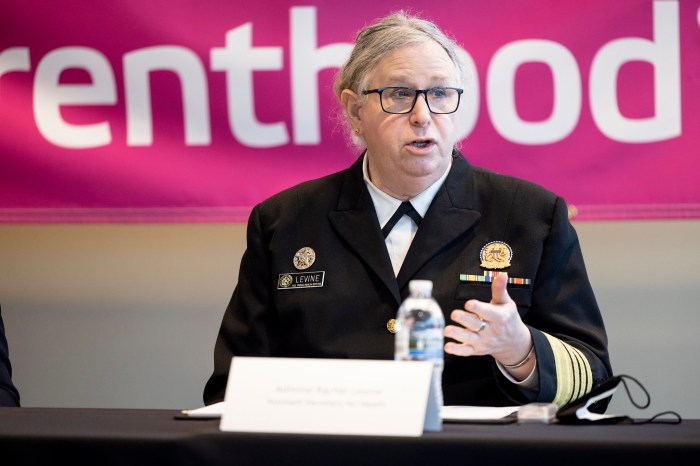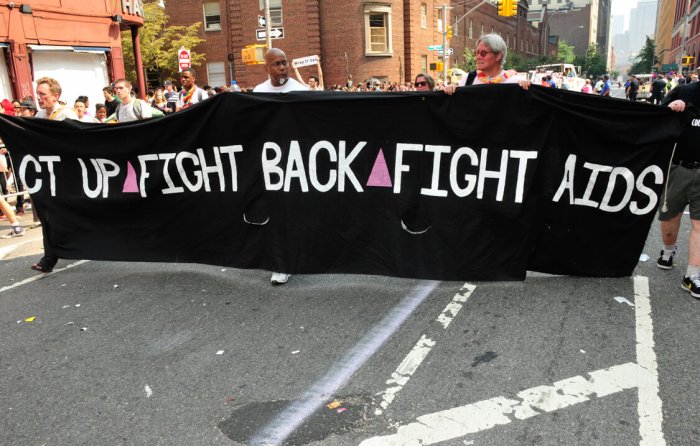At Community Board 2 meeting, advocates, showing flexibility, welcomed
LGBT community worries that opposition could block a Greenwich Village park commemorating the devastation of AIDS and the heroic struggle against it were eased at an October 20 Community Board 2 meeting.
The Queer History Alliance, which is promoting the idea of the park, and its supporters were a strong presence at the CB2 meeting, but the feared donnybrook did not develop. Instead, a friendly amendment to a resolution supporting the effort paved the way for amicable discussions in the near future.
The triangular park, bordered by 12th Street and Seventh and Greenwich Avenues, was part of the adjacent campus of the bankrupt St. Vincent’s Hospital and is slated to remain open space in any redevelopment plan for the area. City land use law, however, requires community board input on the specifics of any plan initiated.
The master plan under discussion calls for replacing the hospital with condo apartments, an elementary school, and a much smaller medical facility. At the meeting, CB 2 reviewed the entire project as yet another step in a lengthy community input process in advance of sending a recommendation on to city planners.
The disposition of the park is a very small part of the proposal from developer Rudin Management. But it satisfies a requirement for preserving open space. In the resolution now under consideration, the Community Board recognizes that St. Vincent’s was the epicenter of the AIDS epidemic in New York during the 1980s.
In a packed hall at PS 130 in Little Italy, most of the audience was there to comment pro or con on the larger development plan, which has drawn considerable fire because the loss of St. Vincent’s forces Villagers to go to the East Side, uptown, or all the way downtown in emergency medical situations.
Not a single opponent of the Rudin plan mentioned the proposed AIDS memorial as a concern.
Even though the community board’s resolution, when finalized, will legally be only advisory, in political terms it will be crucial and become part of the official record considered by the City Planning Commission when it drafts changes in zoning laws. The language agreed on in the wake of the board meeting recognizes the importance of commemorating the fight against AIDS, and advocates of the park left pleased they had a framework for reaching a positive outcome in the months to come.
Still, they left nothing to chance, giving the audience an earful on the merits of the idea. Thirty-five supporters of the park –– all ages, all colors, all sexualities, HIV-positive people, and widowed lovers who lost partners to the epidemic –– signed up to speak. Activists and caregivers wore the green triangle badges distributed by Christopher Tepper and Paul Kelterborn, the Queer History Alliance’s founders. Tepper’s daytime job is as director of development and planning at the Brooklyn Navy Yard Development Corporation, while his associate is a public programs project director at the Municipal Art Society of New York.
Since this spring, the two have met with LGBT leadership, the public health community, CB 2 members, and neighbors of the triangle to develop a “permanent beautiful place” that Tepper said would “commemorate the community’s valiant response” to AIDS. Their proposal includes the removal of unsightly oxygen tanks making the park –– at 15,102 square feet –– the neighborhood’s largest triangular open space. The plan would also convert the 10,000 square-foot basement of a former hospital utility building into a museum and learning center.
Michael Seltzer, who lives across the street from the land and is on the proposed park’s advisory board, noted Lower Manhattan’s tradition as a neighborhood of conscience –– including as it does the 9-11 Memorial, the Lower East Side Tenement Museum, the National Museum of the American Indian, the Irish Hunger Memorial, the Museum of Jewish Heritage, the Museum of Chinese in America, and the African Burial Ground National Monument. An AIDS memorial would be an apt fit, he said.
The founders hope that a memorial park would commemorate the role the former hospital played in responding, especially in the earliest years, to the sudden health emergency, but would also celebrate the activism of Villagers in decisively organizing in response –– creating institutions from Gay Men’s Health Crisis to ACT UP. That latter group, in particular, spurred a dramatic change in the nation’s health care culture, by demanding that the approval process for new drugs be prioritized by the federal government. The government and pharmaceutical companies no longer carry out their work in a vacuum, immune from consumer oversight and advocacy.
Mark Eagle was typical of younger speakers at the meeting in emphasizing his generation’s need to recognize “an entire generation contaminated and condemned. Countless people wasted away to nothing. I am so fortunate, but I can honor those who are not as fortunate. We know, but other people may not know.”
In the spirit of the mutual respect that came out of the meeting –– which contrasted starkly with the concerns earlier expressed by CB 2 chair Brad Hoylman to the New York Times that the park had become a “hot potato” –– the resolution recognizes that “a very strong case has been made for designing the new park around the commemoration of the AIDS epidemic,” but added, “The design process should engage and seek to incorporate this idea, but should not be led by it. The community has indicated it does not support a design that creates a solemn meditative park environment that discourages any other park use.”
The Queer History Alliances fully accepts the notion that the park should be accessible to the community, and is in agreement with language that notes, “While memorials are usually monumental and less cheerful and intimate than the features of community parks, there is no reason why successful commemoration cannot be designed and placed in a way to coexist with and enhance a community park, especially where the history is so deeply connected to the community and the site.”
Tepper declared the evening a success, saying he believes that potential opponents of the project now understand the depth of emotion embedded in his group’s proposal. Noting the need to accommodate a wide array of park uses, Seltzer noted that AIDS Memorial Park is, at this stage, only the Queer History Alliance’s working title for the proposed project.

































